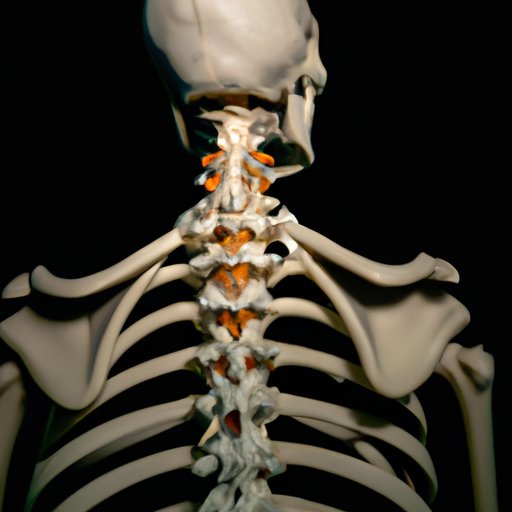Introduction
The human body is a complex machine that requires numerous components working in tandem to support and protect us. One critical consideration is the axial skeleton, which plays a vital role in maintaining the body’s overall structure and providing support for movement.
This article aims to provide readers with a comprehensive overview of the axial skeleton, including the specific bones that make up this essential component of the human body.
Understanding the Axial Skeleton: A Guide to the Bones That Support Your Body
The axial skeleton, as the name suggests, is the primary structure that supports the body along its axis, or its central line. It is made up of 80 bones: the skull, spine, sternum, and ribs.
The bones of the skull provide protection for the brain, while the vertebrae, located in the spine, provide support and mobility for the torso, neck, and head. The sternum, on the other hand, supports the chest, while the ribs encase the vital organs and aid in respiration.
The Vital Role of the Skull: Why Cranial Bones are Essential to Your Health
The skull is perhaps the most critical bone within the axial skeleton as it protects the brain and other vital organs such as the eyes and ears. The skull is made up of 22 bones that include the cranial bones and the facial bones. The cranial bones protect the brain by forming the cranium, while the facial bones provide a foundation for the face.
Having a strong skull is crucial for overall health, as head injuries or trauma can cause significant damage to the brain and can be life-threatening in some cases. Therefore, it’s important to keep the skull healthy to minimize the risk of such injuries.
The Backbone of Your Body: The Role of Vertebrae in Supporting Movement
The spine is made up of 33 vertebrae, and these bones encase the spinal cord. The vertebrae are divided into five sections- cervical, thoracic, lumbar, sacral, and coccygeal – and serve as the central support system for the body. Each of these vertebrae has a unique structure that enables the spine to be flexible yet stable.
The vertebrae play a critical role in supporting the body and enabling mobility. They work alongside the muscles and nerve fibers in the body to maintain an upright posture, perform activities like twisting and bending, and protect the spinal cord from harm.
Beyond the Skull and Spine: Other Bones That Make Up the Axial Skeleton
In addition to the skull and spine, there are other important bones that make up the axial skeleton. The sternum, located at the front of the chest, anchors the ribs that surround and protect the heart and lungs. The ribs, which are 24 in total, curve around the chest wall, and together with the sternum, form the ribcage. Injuries to the ribcage can be painful and can make it challenging to breathe properly.
Another lesser-known bone that forms part of the axial skeleton is the hyoid bone. This bone is a U-shaped structure located in the neck and is essential for supporting the tongue and other muscles that control the mouth’s movements. It also plays an important role in the process of swallowing.
The Evolution of the Axial Skeleton: How Humans and Other Animals Have Adapted Over Time
As an essential part of the body, the axial skeleton has undergone changes over time as different species adapt to their environment. For example, the axial skeleton of whales has evolved to support life underwater, allowing them to dive to great depths and endure extreme pressure changes. Similarly, primates have developed unique spinal structures to support their bipedal posture and enable complex movements.
Conclusion
The axial skeleton is an essential component of the human body, providing vital support and protection for our vital organs and facilitating movement. Neglecting the axial skeleton can lead to significant health problems, including chronic back pain, respiratory issues, and even nerve damage.
It’s crucial to take care of the axial skeleton to maintain overall health and wellbeing. A balanced diet, regular exercise, and proper posture can help keep the bones in the axial skeleton healthy and working correctly, giving you the best possible chance for a happy and healthy life.
